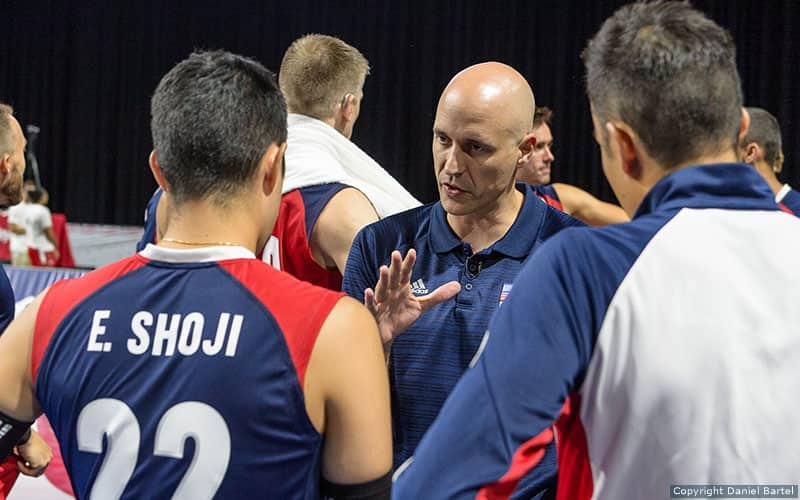
Originally published in the spring 2016 issue of VolleyballUSA, compiled by Don Patterson
In the national team gym, guidance is never framed in don’ts – as in “Don’t do this!” USA players and coaches much prefer to verbalize teaching points in a positive way, and members of the USA Volleyball’s coaching education staff share the same philosophy.
“There’s an old adage that says, ‘Don’t ever tell a kid not to put beans up his nose because the first thing the kid will do is put beans up his nose,’” said U.S. Women's National Team head coach Karch Kiraly. “So, if I’m a coach, and I’m about to send in a serving sub, the last thing I want to say is, ‘Whatever you do, don’t miss.’ What’s going to stick in her mind? The words ‘miss’ and don’t.’ And I’m going to stress her out. I know there are coaches who have told players not to miss before going in to serve, but I’ve never had a player tell me, ‘You know what, that was a huge help. That made me a lot better server.’”
10 Things You Should Do on the Court
From top head coaches ...
Outside hitters: Focus on the first contact before thinking about the third contact.
The most important thing for outside hitters is to make sure you take care of that first contact – the pass – and then worry about what you’re going to hit and where you’re going to hit it. A lot of outside hitters are so worried about their attack that they really lose sight of their primary responsibility – taking care of the pass. – Hugh McCutcheon, Minnesota; two-time U.S. Olympic coach
Be disciplined with your block and avoid reaching out for the ball or drifting.
You have to fight your instincts on this one because reaching out and drifting causes two problems: 1. By reaching out instead of penetrating, you create an easy target for an attacker to use or tool; 2. It also creates a split in the block, making it tougher for the defense to read and easier for the attacker to bury the ball. Instead, focus on a disciplined block that presses over and toward the center of the court. – Christy Johnson-Lynch, Iowa State
Set attackers who are asking for the ball.
If they aren’t asking for the ball, avoid them. Note to hitters: don’t ask for the ball unless you are positioned to attack it. – Russ Rose, Penn State
When attacking, adjust your approach to the set.
Attackers find themselves in all kinds of offensive situations. If you’re an outside hitter, you might get 50 percent of your sets exactly where you want them and 50 percent that are high, low, wide, tight, etc. Read the situation, adjust your approach and choose your setup. Practicing with a focus on these things will not only improve your performance, it will help you stay healthy. – John Dunning, retired Stanford coach
Serve it in after 20, after timeouts, and when your opponent or teammate has just missed.
You don’t want to serve underhand, but there are certain times when you can’t afford an error. You have to make the other team work. – Mick Haley, 2000 U.S. Olympic coach
In beach, keep talking to your partner.
The key to the beach game is communication. No matter how in the tank you or your partner may be, you will never work out of it by going silent. Keep your body language positive, too. It’s easy for negative emotions to fill blank space. So when things go south, keep your chin up and talk it through. – Anna Collier, Southern Cal
Setters: Take tight passes and keep your hitters off the net.
All great setters do this. Don’t think that a tight pass equals a tight set. – John Cook, Nebraska
Understand that you’re always involved in the play.
When the ball gets set to the other pin hitter, I bet you that 90 percent of athletes stop and watch their teammate hit the ball. Invariably, the hitter coverage that is most needed is that person, because the ball has a funny way of finding that side of the court. And that person isn’t in an athletic enough position to react. That’s a mistake you should never make. I tell people, ‘If you want to stand around, go stand around on the bench.’ – John Speraw, UCLA; U.S. Men's National Team head coach
Setters: Error high rather than low when setting the middle attacker.
The setter middle connection is something that takes time, but, as you are working on this connection, it’s always important to error on the higher side. At least if the ball is a bit too high, the middle can still tip it in. If you under-set a middle, they will likely hit into the net. – Lizzy Stemke, former coach at Georgia
Be ready to play
You are in complete control of getting yourself mentally and physically prepared for a match, whether it’s following a certain warm-up routine, stretching, sprinting, visualizing, hitting a bunch of balls – whatever works for you. So often, I see players – especially young players – who are not ready to play. To play great volleyball, you need to be disciplined and take care of this. Be ready to compete. – Todd Rogers, Cal Poly; 2008 Olympic gold medalist
